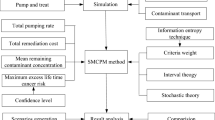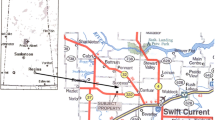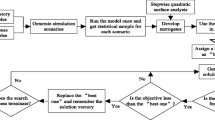Abstract
In this study, a human health risk constrained groundwater remediation management program based on the improved credibility is developed for naphthalene contamination. The program integrates simulation, multivariate regression analysis, health risk assessment, uncertainty analysis, and nonlinear optimization into a general framework. The improved credibility-based optimization model for groundwater remediation management with consideration of human health risk (ICOM-HHR) is capable of not only effectively addressing parameter uncertainties and risk-exceeding possibility in human health risk but also providing a credibility level that indicates the satisfaction of the optimal groundwater remediation strategies with multiple contributions of possibility and necessity. The capabilities and effectiveness of ICOM-HHR are illustrated through a real-world case study in Anhui Province, China. Results indicate that the ICOM-HHR would generate double remediation cost yet reduce approximately 10 times of the naphthalene concentrations at monitoring wells, i.e., mostly less than 1 μg/L, which implies that the ICOM-HHR usually results in better environmental and health risk benefits. And it is acceptable to obtain a better environmental quality and a lower health risk level with sacrificing a certain economic benefit.










Similar content being viewed by others
References
Abdurabu WA, Ramli AT, Saleh MA, Heryansyah A (2016) The activity concentrations of Rn-222 and corresponding health risk in groundwater samples from basement and sandstone aquifer; the correlation to physicochemical parameters. Radiat Phys Chem 127:34–41
Ajay K, Manpreet K, Rohit M, Sumit S, Rosaline M, Singh KP, Bajwa BS (2016) Quantification and assessment of health risk due to ingestion of uranium in groundwater of Jammu district, Jammu & Kashmir, India. J Radioanal Nucl Ch 310:793–804
Ansaf KVK, Ambika S, Nambi IM (2016) Performance enhancement of zero valent iron based systems using depassivators: optimization and kinetic mechanisms. Water Res 102:436–444
Chakraborti D, Rahman M, Ahamed S, Dutta R, Pati S, Mukherjee SC (2016) Arsenic contamination of groundwater and its induced health effects in Shahpur block, Bhojpur district, Bihar state, India: risk evaluation. Environ Sci Pollut Res 23(10):9492–9504
de Barros FPJ, Bellin A, Cvetkovic V, Dagan G, Fiori A (2016) Aquifer heterogeneity controls on adverse human health effects and the concept of the hazard attenuation factor. Water Resour Res 52:5911–5922
De Gisi S, Notarnicola M (2016) Waste minimization in the remediation of contaminated sites: using the oil belt skimmer technology for the removal of heavy hydrocarbons from groundwater. Environ Sci Pollut Res 23(23):24092–24106
Dong HH, He L, Lu HW, Li J (2016) A microbial growth kinetics model driven by hybrid stochastic colored noises in the water environment. Stoch Environ Res Risk Assess. doi:10.1007/s00477-016-1282-y
Driver JH, Price PS, Van Wesenbeeck I, Ross JH, Gehen S, Holden LR, Landenberger B, Hastings K, Yan ZY, Rasoulpour R (2016) Evaluation of potential human health effects associated with the agricultural uses of 1,3-D: spatial and temporal stochastic risk analysis. Sci Total Environ 571:410–415
Dubois D, Prade H (1992) When upper probabilities are possibility measures. Fuzzy Sets Syst 49:65–74
Fan X, He L, Lu HW, Li J (2014) Environmental- and health-risk-induced remediation design for benzene-contaminated groundwater under parameter uncertainty: a case study in western Canada. Chemosphere 111:604–612
Fonkwe MLD, Trapp S (2016) Analyzing tree cores to detect petroleum hydrocarbon-contaminated groundwater at a former landfill site in the community of Happy Valley-Goose Bay, eastern Canadian subarctic. Environ Sci Pollut Res 23(16):16137–16151
Goodarzi M, Abedi-Koupai J, Heidarpour M, Safavi HR (2016) Development of a new drought index for groundwater and its application in sustainable groundwater extraction. J Water Res Plan Man 142. doi:10.1061/(ASCE)WR.1943-5452.0000673
Guan JB, Aral MM (2004) Optimal design of groundwater remediation systems using fuzzy set theory. Water Resour Res 40 (1) doi:10.1029/2003WR002121
Henri CV, Fernandez-Garcia D, de Barros FPJ (2016) Assessing the joint impact of DNAPL source-zone behavior and degradation products on the probabilistic characterization of human health risk. Adv Water Resour 88:124–138
Heydari F, Saghafian B, Delavar M (2016) Coupled quantity-quality simulation-optimization model for conjunctive surface-groundwater use. Water Resour Manag 30:4381–4397
Huang XH (2006) Credibility-based chance-constrained integer programming models for capital budgeting with fuzzy parameters. Inf Sci 176(18):2698–2712
Islam A, Ahmed A, Hur M, Thorn K, Kim S (2016) Molecular-level evidence provided by ultrahigh resolution mass spectrometry for oil-derived doc in groundwater at Bemidji, Minnesota. J Hazard Mater 320:123–132
Kozyatnyk I, Bouchet S, Bjorn E, Haglund P (2016) Fractionation and size-distribution of metal and metalloid contaminants in a polluted groundwater rich in dissolved organic matter. J Hazard Mater 318:194–202
Kumar RS, Goswami A (2015) A fuzzy random EPQ model for imperfect quality items with possibility and necessity constraints. Appl Soft Comput 34:838–850
Kuppusamy S, Palanisami T, Megharaj M, Venkateswarlu K, Naidu R (2016a) In-situ remediation approaches for the management of contaminated sites: a comprehensive overview. Rev Environ Contam T 236:1–115
Kuppusamy S, Palanisami T, Megharaj M, Venkateswarlu K, Naidu R (2016b) Ex-situ remediation technologies for environmental pollutants: a critical perspective. Rev Environ Contam T 236:117–192
Leach JM, Coulibaly P, Guo YP (2016) Entropy based groundwater monitoring network design considering spatial distribution of annual recharge. Adv Water Resour 96:108–119
Langwaldt JH, Puhakka JA (2000) On-site biological remediation of contaminated groundwater: a review. Environ Pollut 107(2):187–197
Li J, He L, Lu H, Fan X (2014) Stochastic goal programming based groundwater remediation management under human-health-risk uncertainty. J Hazard Mater 279:257–267
Li J, He L, Lu HW, Fan X (2015) Control of stochastic carcinogenic and noncarcinogenic risks in groundwater remediation through an integrated optimization design model. Stoch Env Res Risk Assess 29:2159–2172
Llopis-Albert C, Merigo JM, Xu YJ (2016) A coupled stochastic inverse/sharp interface seawater intrusion approach for coastal aquifers under groundwater parameter uncertainty. J Hydrol 540:774–783
Lu H, Du P, Chen Y, He L (2016a) A credibility-based chance-constrained optimization model for integrated agricultural and water systems management: a case study in south central China. J Hydrol 537:408–418
Lu H, Xu Z, Fan X, Ren L, He L (2016b) Meta-modeling based health risk assessment of naphthalene contamination in coal-contaminated groundwater. Hum Ecol Risk Assess 22(8):1602–1619
Luo QK, Wu JF, Yang Y, Qian JZ, Wu JC (2016) Multi-objective optimization of long-term groundwater monitoring network design using a probabilistic Pareto genetic algorithm under uncertainty. J Hydrol 534:352–363
Majumder P, Eldho TI (2016) A new groundwater management model by coupling analytic element method and reverse particle tracking with cat swarm optimization. Water Resour Manag 30:1953–1972
Manamsa K, Crane E, Stuart M, Talbot J, Lapworth D, Hart A (2016) A national-scale assessment of micro-organic contaminants in groundwater of England and Wales. Sci Total Environ 568:712–726
Matott LS, Rabideau AJ, Craig JR (2006) Pump-and-treat optimization using analytic element method flow models. Adv Water Resour 29(5):760–775
Minsker BS, Shoemaker CA (1998) Dynamic optimal control of in situ bioremediation of groundwater. J Water Res Plan Man 124(3):149–161
Nalbantcilar MT, Pinarkara SY (2016) Public health risk assessment of groundwater contamination in Batman, Turkey. J Water Health 14:650–661
Park S, Kim HK, Kim MS, Lee GM, Song DH, Jeon SH, Kim Y, Kim TS (2016) Monitoring nitrate natural attenuation and analysis of indigenous micro-organism community in groundwater. Desalin Water Treat 57:24096–24108
Piscopo AN, Neupauer RM, Kasprzyk JR (2016) Optimal design of active spreading systems to remediate sorbing groundwater contaminants in situ. J Contam Hydrol 190:29–43
Prabodanie RAR (2016) Optimal positioning of groundwater supply wells in residential areas with uncertain information. J Natl Sci Found Sri 44:233–242
Rong A, Lahdelma R (2008) Fuzzy chance constrained linear programming model for optimizing the scrap charge in steel production. Eur J Oper Res 186:953–964
Salifu A, Petrusevski B, Mwampashi ES, Pazi IA, Ghebremichael K, Buamah R, Aubry C, Amy GL, Kenedy MD (2016) Defluoridation of groundwater using aluminum-coated bauxite: optimization of synthesis process conditions and equilibrium study. J Environ Manag 181:108–117
Salmani-Ghabeshi S, Palomo-Marin MR, Bernalte E, Rueda-Holgado F, Miro-Rodriguez C, Cereceda-Balic F, Fadic X, Vidal V, Funes M, Pinilla-Gil E (2016) Spatial gradient of human health risk from exposure to trace elements and radioactive pollutants in soils at the Puchuncavi-Ventanas industrial complex, Chile. Environ Pollut 218:322–330
Schmidt SA, Gukelberger E, Hermann M, Fiedler F, Grossmann B, Hoinkis J, Ghosh A, Chatterjee D, Bundchuh J (2016) Pilot study on arsenic removal from groundwater using a small-scale reverse osmosis system—towards sustainable drinking water production. J Hazard Mater 318:671–678
Serra-Roig MP, Jurado A, Diaz-Cruz MS, Vazquez-Sune E, Pujades E, Barcelo D (2016) Occurrence, fate and risk assessment of personal care products in river-groundwater interface. Sci Total Environ 568:829–837
Sharma S, Kaur J, Nagpal AK, Kaur I (2016) Quantitative assessment of possible human health risk associated with consumption of arsenic contaminated groundwater and wheat grains from Ropar Wetland and its environs. Environ Monit Assess:188. doi:10.1007/s10661-016-5507-9
Sheu YT, Lien PJ, Chen KF, Ou JH, Kao CM (2016) Application of NZVI-contained emulsified substrate to bioremediate PCE-contaminated groundwater—a pilot-scale study. Chem Eng J 304:714–727
Shin W, Oh J, Chong S, Cho BW, Lee KS, Yun U, Woo NC, Kim HK (2016) Distribution and potential health risk of groundwater uranium in Korea. Chemosphere 163:108–115
Stratis PN, Karatzas GP, Papadopoulou EP, Zakynthinaki MS, Saridakis YG (2016) Stochastic optimization for an analytical model of saltwater intrusion in coastal aquifers. PLoS One 11. doi:10.1371/journal.pone.0162783
USEPA (United States Environmental Protection Agency), National Recommended water quality criteria, 2009
Yu Y (2011) Health risk assessment and management techniques of environmental pollution. China Environmental Science Press, Beijing
Zhang YM, Lu HW, Nie XH, He L, Du P (2014) An interactive inexact fuzzy bounded programming approach for agricultural water quality management. Agric Water Manag 133:104–111
Zhang S, Mao G, Crittenden J, Liu X, Du H (2017) Groundwater remediation from the past to the future: a bibliometric analysis. Water Res Doi. doi:10.1016/j.watres.2017.01.029
Zhou W, Fu D, Sun Z (1991) Determination of black list of China’s priority pollutants in water. Res Environ Sci 4(6):9–12
Acknowledgements
This research was supported by the China National Funds for Excellent Young Scientists (51422903), China Postdoctoral Science Foundation (2016M600069), and Fundamental Research Funds for the Central Universities.
Author information
Authors and Affiliations
Corresponding author
Additional information
Responsible editor: Philippe Garrigues
Rights and permissions
About this article
Cite this article
Li, J., Lu, H., Fan, X. et al. Human health risk constrained naphthalene-contaminated groundwater remediation management through an improved credibility method. Environ Sci Pollut Res 24, 16120–16136 (2017). https://doi.org/10.1007/s11356-017-9085-3
Received:
Accepted:
Published:
Issue Date:
DOI: https://doi.org/10.1007/s11356-017-9085-3




